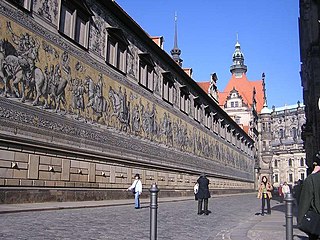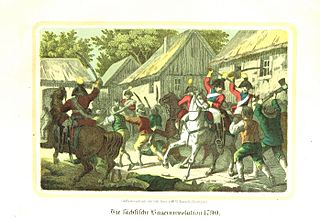
Meissen is a town of approximately 30,000 about 25 km (16 mi) northwest of Dresden on both banks of the Elbe river in the Free State of Saxony, in eastern Germany. Meissen is the home of Meissen porcelain, the Albrechtsburg castle, the Gothic Meissen Cathedral and the Meissen Frauenkirche. The Große Kreisstadt is the capital of the Meissen district.
The Brunonids were a Saxon noble family in the 10th and 11th centuries, who owned property in Eastphalia and Frisia.
Gertrud of Brunswick was Countess of Katlenburg by marriage to Dietrich II, Count of Katlenburg, Margravine of Frisia by marriage to Henry, Margrave of Frisia, and Margravine of Meissen by marriage to margrave Henry I. She served as regent of the County of Katlenburg during the minority of her son Dietrich III of Katlenburg, and as regent of the County of Northeim during the minority of her son Otto III of Northeim. She was also one of the leaders of the insurrections against Emperor Henry IV and his son Henry V.
Theodoric I, called the Oppressed, was the Margrave of Meissen from 1198 until his death. He was the second son of Otto II, Margrave of Meissen and Hedwig of Brandenburg.
Dobroniega Ludgarda of Poland was a Polish princess, Margravine of Lusatia by marriage to Theodoric I, Margrave of Lusatia.

Dietrich I von Hengebach was the Archbishop of Cologne. He was elected in 1208. He supported Otto of the House of Welf as Holy Roman Emperor and was excommunicated in 1212 by Innocent III. Upon his excommunication, he lost the Episcopal see and he brought suit in Rome. His suit was rejected in 1215, after which he retired to the Deanery of Saint Apostles in Cologne, where he died after 1223.

The Fürstenzug in Dresden, Germany, is a large mural of a mounted procession of the rulers of Saxony. It was originally painted between 1871 and 1876 to celebrate the 800th anniversary of the Wettin Dynasty, Saxony's ruling family. In order to make the work weatherproof, it was replaced with approximately 23,000 Meissen porcelain tiles between 1904 and 1907. With a length of 102 metres (335 ft), it is known as the largest porcelain artwork in the world. The mural displays the ancestral portraits of the 35 margraves, electors, dukes and kings of the House of Wettin between 1127 and 1904.

The Saxon Peasants' Revolt of 1790 was a military conflict between the nobility and the peasants. The hot spots of the insurrection were large areas around Dresden, Leipzig and Zwickau.
Henry VI of Plauen was Burgrave of Meissen, Lord of Plauen and Lord of Schleiz and Lobenstein.

Hedwig of Brandenburg, also called Hedwig of Ballenstedt, a member of the House of Ascania, was Margravine of Meissen from 1156 until 1190 by her marriage with Margrave Otto II.
Margrave Conrad II of Lusatia, also known as Margrave Konrad II of Landsberg, was a member of the House of Wettin. He was Count of Eilenburg and Margrave of Lusatia from 1190 until his death. From 1207, he was also Count of Groitz and Count of Sommerschenburg. He was a son of Margrave Dedi III and his wife, Matilda of Heinsberg, the heiress of Sommerschenburg.
Saint Burchard of Meissen was the first Bishop of Meissen, from 968.
Dietrich I, otherwise Theoderich, was Bishop of Meissen from 1024 to late 1039 or early 1040.
Albrecht I of Meissen was Bishop of Meissen from 1150 to 1152.
Gerung was bishop of Meissen from 1152 to 1150, and previously abbot of Posa or Bosau Abbey.
Martin was Bishop of Meissen from 1170 to 1190.
Bruno von Porstendorf otherwise Bruno II of Meissen or Bruno II von Porstendorf was Bishop of Meissen from 1209 to 1228.
Heinrich of Meissen was Bishop of Meissen from December 1228 to his death.
Albrecht von Mutzschen otherwise Albrecht II of Meissen or Albrecht II von Mutzschen was Bishop of Meissen from 1258 to 1266.
Withego von Furra or de Wuor, otherwise Withego I of Meissen or Withego I von Furra was Bishop of Meissen from 1266 to his death.
This page is based on this
Wikipedia article Text is available under the
CC BY-SA 4.0 license; additional terms may apply.
Images, videos and audio are available under their respective licenses.




